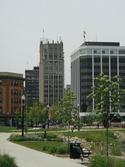Cuyahoga County Treasurer Jim Rokakis, who is based in Cleveland, estimates that new census numbers might show Cleveland's population to be 325,000, a whopping 153,000 drop in 10 years! That would be an average of 15,000 people leaving Cleveland every year.
That’s 1,250 people jumping ship every month,
312 people fleeing the wreckage every week,
45 people evacuating every day, or
2 people running out of Cleveland every hour, 24/7, the whole year, for 10 straight years. read more »






















